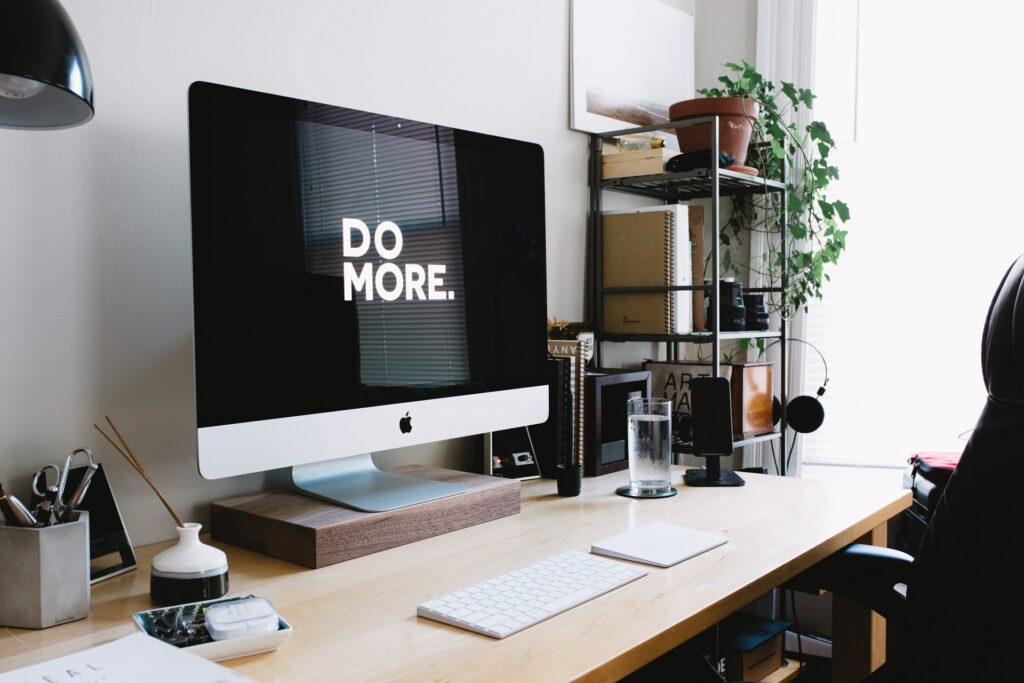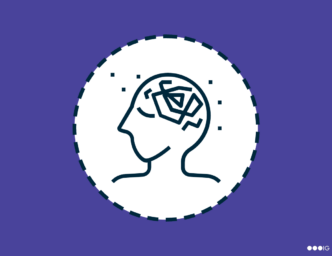How does your work desk look? Is it organized with spots for your pens, important folders, sticky notes, and your work calendar? How about your computer? Do all your files have properly named folders, and do you know where all of your important documents live?
These all seem like small conveniences, but when added up, they can make your desk optimized for work. An organized desk space can help increase your productivity, and this blog post will explain how to organize your desk to help you do just that.
Why organizing your desk is important
When your desk is organized, you’re able to work more efficiently and effectively. When everything has a place and everything is in its place, you don’t have to waste time searching for things or trying to figure out where you put them. This not only saves you time, but it also helps reduce stress since you know exactly where everything is.
This rings true for desks in an office space or for remote employees in a home office. No matter the location of your desk, you’ll do better work if it’s a place that encourages productivity.
How to organize your desk
Now let’s get into the nitty gritty of how to organize your desk. These 30 tips will allow you to best optimize your work space for cleanliness, efficiency, and success.
1. Make sure to keep some space clear
Always make sure to leave some space on clear on your desk for work. This may seem like common sense, but it’s amazing how many people fill their desks up to the point where there’s no room to write things down or move things around. This space should be at least big enough to be able to comfortably write on a notepad, and you shouldn’t have to move anything (laptop, mouse, mouse pad) to free up room.
2. Create zones
Another way to organize your desk is by creating zones. Divide your desk into different areas for specific tasks such as working on the computer, writing, and task organization. Not only does this help keep everything organized, but it also makes it easier for you to transition between tasks.
3. Use storage containers and organizers
One of the best ways to organize your desk is by using storage containers and organizers. This can include anything from file folders to boxes to baskets. Dividers and baskets can also help keep drawers and your desk nice and clean. If your desk has stuff on it you rarely use, perhaps store it in a container and label it so you remember it’s in there. (More on that in just a second.)
All of these items help declutter your desk and make it easier to find what you’re looking for.
4. Label everything
If you want to take desk organization to the next level, consider labeling everything. This includes everything in and around your desk. By doing this, you’ll know exactly where everything is, and you won’t have to waste time searching for things. You can use markers and tape, sticky notes, or a label maker to help you label items.
5. Add inspiration
You can add inspiration to your desk by adding items that make you happy or motivated. This could be anything from some family photos to inspirational quotes to items like a small plant. By surrounding yourself with things that inspire you and make you feel good, you’ll be more likely to stay focused and productive.

6. Include personal touches
Always make sure to include some personal touches. Like we mentioned in the last section, photos of family or friends can help accomplish this task. Add pictures and items that show off your personality and interests. By adding these personal touches, you’ll make your desk feel like home, and you’ll be more likely to enjoy working at it.
7. Transition what you can from physical to digital
There are many things that you can transition from physical form to the digital space in today’s world. For example, instead of storing paper files, you can keep them electronically on your computer. A large desk calendar may be taking up unnecessary space when you have a calendar app on your computer.
Anything you can move from physical form to digital, it will help create space for you to work. It will also be more eco-friendly.
8. Stick to the essentials
Remember that your desk is a place to work, not a place to store everything you own. Make sure to only keep the essentials and work-related items on your desk and store the rest elsewhere (like in cabinets, containers, or–and some of you need to hear this–the garbage can).
For at-home setups, it may be useful to have a second working space for personal tasks. This allows you to keep personal items separate from your work space.
9. Get a trash can
Make sure to get a trash can. It is a simple convenience, but it’s a major step in keeping your desk clean. Having to walk an extra 15 to 20 feet to throw something out may cause that piece of trash to stick around your desk longer than it should.
10. Complete an occasional overhaul
Periodically totally overhaul your desk and get rid of the things you no longer need. This could be anything from old papers to unused office supplies. By doing this, you’ll make more room on your desk for the things you use regularly.

11. Work on one thing at a time
When you’re working on your desk, make sure to focus on one thing at a time. Try to not have too many files or tabs related to different tasks open at the same time. While things like browser tabs and Word files aren’t extremely physically cluttering, they can certainly cause a mental clutter and prevent you from accomplishing tasks you need to.
12. Set up a filing system
One of the best ways to organize your desk is to set up a filing system–both physically and digitally. If you need papers and binders at your desk, use file and paper sorters to give everything its place. (Remember: put a label everything, too!)
On your desktop, make sure all of your important documents are stored in aptly named folders. Those folders can have subfolders that help give everything on your computer a specific place to live.
13. Organize your office supplies
Desk organizers and caddies can be very helpful in clearing up space. They can help you store everything from pens to paper clips to sticky notes. They ensure things aren’t rolling around in a drawer or out on your work space. Return everything to the desk organizer once you’re done using it, too.
Anything that you have in bulk–like extra pens, printer paper, highlighters, etc.–can be stored in a closet (which should also be organized so office supplies can be found easily).
14. Tether your cables
One of the best ways to organize your desk is to tether the cables connecting all of your technology. With regards to technology, a typical desk can have a(n):
- laptop with a charger
- cord connecting a laptop to a monitor (or two)
- phone charger
- extension cord
- surge protector
- ethernet cable connecting internet
- internet router
This isn’t even an entire list for some people. Tether as many cables together as you can help keep them controlled and, if you choose, off the floor. From a visual standpoint, it also helps everything look less cluttered and hectic, which can ease anxieties that come from unorganized spaces.

15. Keep a notebook handy
It can be helpful to keep a notebook handy at your desk. You can use write down any ideas or thoughts that come to mind. It’s a great way to store plans or ideas so you don’t forget them.
16. Have a place to store finished tasks
Once a task is completed, have a place you can store it to access it later (if needed). Filing folders and boxes help with this.
If you don’t need the papers associated with the task, you can shred and recycle them.
17. Sort things by importance
For tasks you still have to do, sort them by importance or by which ones you want to get done first. This will give your desk some organization, but it will also help organize your thoughts and plans for the work week.
18. Find a calendar that works best for you
Calendars are crucial for organization. They help keep track of all of your appointment, meetings, deadlines, and other tasks that need to be tracked. Find one that works best for you.
Digital calendars and organizers are preferred (they reduce desk clutter and can notify you when something comes up), but if you desire a physical calendar, try to get one you can hang up on a wall. It will help keep your desk open for work.
19. Organize your computer desktop
Are you a “my desktop background is covered by 200 folders, screen shots, and documents” kind of person or an “I can see my desktop background” kind of person? If you’re either person, does this stem from the fact that everything is organized?
It’s okay to have a ton of folders on your desktop–just make sure they all have a purpose and are easily findable and navigable. If your desktop is relatively clear, make sure all of your important files aren’t floating around in the ether (a.k.a. the general “documents” folder) and have a specific folder to live in, even if that folder isn’t on the home screen.
20. Toss pens and pencils you don’t use
Those pens that ran out of ink five years ago? Get rid of them. And those pencils that are down to a nub? Get rid of those, too. Any writing utensil (or other office item) that doesn’t work shouldn’t be anywhere near your desk.
21. Use a cart for additional storage space
If you have a lot of office supplies that you need to keep near your desk, consider using a cart for additional storage. This will help keep everything organized and close by, but it help keep your work place clean. You can also move the cart to other parts of your work space if you find it more useful.
22. Scan your documents
As we’ve discussed, removing any unnecessary papers and files from your desk can help keep your space organized. If you still need to keep certain papers on-hand and don’t have the space to store larger quantities of paper, scan them and store them in a folder on your desktop. Label the scanned documents, too, so you know which scanned items are which.

23. Bookcases and shelves
If you don’t have any closets or cabinets to store items, bookcases and shelves can help remove things (folders, binders, books, etc.) from your desk but keep them nearby. They can also add a personality to your work space if you adorn them with personal items.
24. Use magnetic strips
Magnetic strips may most commonly be used for things like knives in the kitchen, but you can add something like this to your work space! Office items like scissors, staplers, and other magnetic items can be raised off your desk and hung on the wall. You can also add magnetic strips to items like pens and markers to make them magnetic and hangable.
25. Hang a pegboard or cork board
If you have a lot of office supplies, consider hanging a peg board or cork board to help get items off your desk and onto the wall. Peg boards allow for customizable shelving that can fit any office need, and cork boards allow you to pin up important documents and items (like your calendar) without letting them get lost on your desk.
26. Create a charging station
By creating a charging station on or close to your desk, you can keep all of your devices in front of you without the hassle of charging them in other rooms. As the charging cables add up, you’ll want to make sure they are tethered and organized, as we discussed before.
27. Use a clamp-on desk lamp to maximize desktop space
A clamp-on desk lamp can be very helpful in maximizing desk space. You can clip this item onto the side of your desk or even onto a monitor (if it’s small enough), and it frees up room the base (and shade) of a lamp would take up.

28. Do a daily wipe down
Do a daily wipe down of your desk. This will keep your desk clean and free of dust. Every so often, you’ll want to pick up everything on your desk and clear any dust off from those areas, too. A clean desk is a productive desk.
29. Maximize the space under your desk
The empty space under your desk is often wasted. This is a great place to store file boxes and other office supplies (like a trash can). You can also make sure cables are tethered and tied to places under your desk. By maximizing this space, you’ll be able to stay more organized and productive.
30. Make sure you label storage boxes
This goes back to the tip about labeling everything. This includes anything you put in a box or container. You don’t want to fill them up with important items then forget where they are.
Conclusion
These are just a few tips on how to organize your desk. If you want to be more productive, we highly recommend implementing at least a handful of these tips. It takes time to implement new habits and purchase new items, but it will all make the time you spend at your desk more efficient and successful.
If you’re looking for a job where you can apply some of these tips, head over to the Insight Global job board.


 by Patrick Glynn
by Patrick Glynn



 by Brita Long
by Brita Long 


 by Anna Morelock
by Anna Morelock